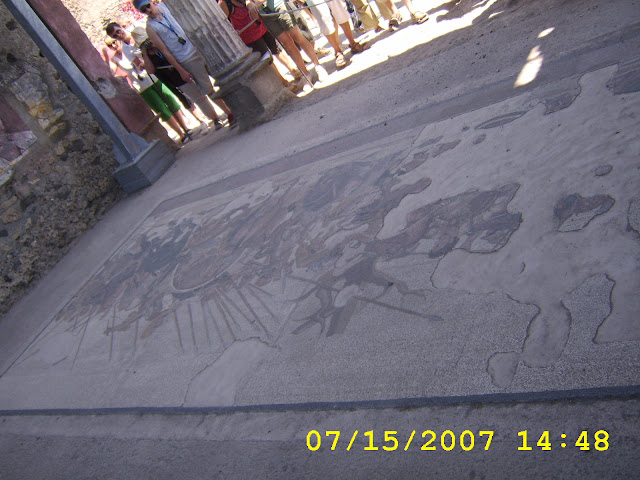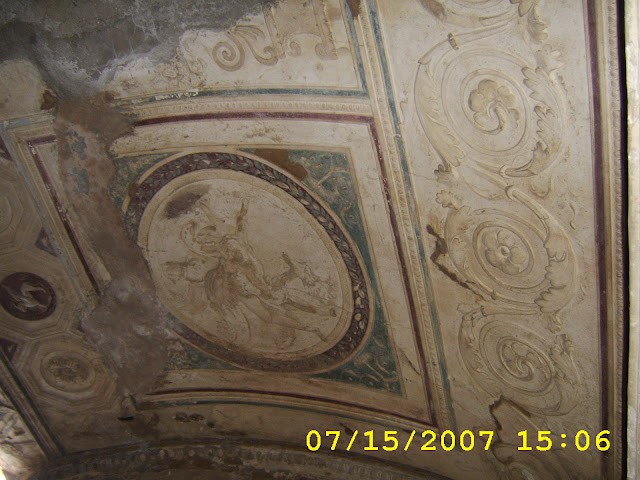Visiting Pompeii is like going back in time. It offered an amazing window in time where we could get a glimpse on how ancient Romans lived their lives. It makes one wonder how people two thousand years from now would view our civilization...
In the early afternoon hours of August 24, 79 A.D. the summit of Mount Vesuvius exploded without warning. A black river of ash and lapilli ran from the crater of the volcano down through the city of Pompeii leaving death and destruction in its wake. The magnificent ancient city of Pompeii was left buried under about 20 feet of earth and ash. Pompeii was originally only 500 meters from the sea, but after the eruption the distance to the sea increased to two kilometers.
The oldest buildings of Pompeii date to the 6th century B.C. and likely only occupied a small part of the south-western area, between the main Forum and the Triangular Forum. Pompeii gradually expanded toward the east and the north. Most of the ruins date back to its establishment as a Roman colony in 80 B.C. To date, about 80% of the ruins at Pompeii have been excavated and studied, giving us a picture of how the city was built and organized. Pompeii was surrounded by a three-kilometer wall containing eight gates.
Monte Vesuvio (Mount Vesuvius), one of the most famous volcanoes in the world, buried the twin Italian cities of Pompeii and Herculaneum during its catastrophic eruption in AD 79. Mount Vesuvius is a stratovolcano in the Bay of Naples, Italy, and was formed by the collision of the African and Eurasian tectonic plates.
The Unexpected Catastrophe
It is certain that when the eruption of Vesuvius started on the morning of 24 August, AD 79, it caught the local population utterly unprepared. Although at the same time, as we now know in retrospect, all the tell-tale signs were there to warn them.
It is mainly thanks to the vivid eye-witness account of Pliny the Younger (a Roman administrator and poet, whose many vivid letters have been preserved), that we have some understanding of what happened. And it is through him that we can gain insight into the reactions and feelings of the people caught up in the drama of this natural catastrophe.
Pliny the Younger's account leaves no doubt that everyone was caught unprepared. His uncle, known as Pliny the Elder, was stationed in command of the imperial naval base at Misenum, on the north-west extremity of the Bay of Naples. He was not only the senior military officer in the district, but possibly the most well informed living Roman on matters of natural science. His 37-volumeNatural History is the longest work on science in Latin that has survived from antiquity.
But for all his science and his seniority, his nephew tells us that the elder Pliny was relaxing, after a bath and lunch, when Vesuvius started to erupt. And the sighting of a column of smoke 'like an umbrella pine' on the far side of the Bay triggered a response more of curiosity than of alarm in him. He and his companions were evidently not anticipating such an event.

The same account reveals, however, that the signs were there. Pliny's casual reference to earth tremors 'which were not particularly alarming because they are frequent in Campania' reveals the Roman's comprehensive ignorance of the link between seismic activity (earth tremors) and volcanic activity.
The volcanologists of today constantly monitor any changes in levels of seismic activity from the observatory on Vesuvius, because they know that the same increase of activity in the deep reservoir of magma (molten or partially molten rock beneath the Earth's surface) causes both earth tremors and volcanic eruptions. Through measuring seismic activity, these scientists expect to predict an approaching eruption months in advance.
They also know that the activity of Vesuvius is recurrent, and that the longer the intervals between one eruption and another, the greater the eventual explosion will be. The frequent but low-level activity of Vesuvius in recent centuries has relieved the build-up of pressure in the magma chamber. The catastrophic magnitude of the eruption of AD 79 was connected with the extended period of inactivity that preceded it. A long interval combined with mounting seismic activity is a sure sign of impending disaster.
Of course, the Romans could not know this, and our own knowledge owes much to the care of Pliny's description. The long inactivity of the volcano naturally lulled the people of the region into a false sense of security, though they were aware of the signs of burning at the peak of the mountain.
They were not the first to be so lulled: recent excavations at the site of the new NATO base at Gricignano, on the north of the Bay, have revealed two catastrophic eruptions that preceded that of 79, and wiped out the populations of a densely occupied territory. The most important earlier eruption, known as that of the 'Avellino pumice' occurred around 1800 BC; several sites, especially one near Nola, reveal the destruction of Bronze Age settlements, with their huts and pots and pans and livestock. But of this the Romans knew nothing.
The Roman philosopher Seneca, advisor to the Roman Emperor Nero, wrote a discussion of the scientific causes of earthquakes only a few years before the eruption. Seneca's treatise on the causes of natural phenomena included an entire book on earthquakes, and at the time he was writing, the news was coming in freshly of the catastrophic earthquakes in Campania of AD 63, which caused extensive damage to both Pompeii and Herculaneum.
Seneca writes that he regarded it as likely that earthquakes in different parts of the world were interconnected, and even that they were linked to stormy weather, but he draws no link with volcanic activity. Indeed, he goes so far as to reproach the landowners who were deserting Campania for fear of further earthquakes.
The Eruption
Taken unawares by the eruption, the population of the towns and villas that circled the Bay could only respond with panic. Pliny depicts his uncle as a model of Stoic fortitude: calmly sailing directly into the danger zone (where he subsequently died), and taking a bath, dinner and sleep while the catastrophe unfolded. But all around him is panic - Rectina in her villa, Pomponianus in his.
The young Pliny too stays calm, but his mother weeps and implores, and by the time they set out to flee northwards, a dense black cloud of ash has blotted out the light, and the crowds of screaming people fleeing around them are in terror. The skeletons found in Pompeii and Herculaneum give us an equally eloquent testimony of panic and uncertainty.
The eruption lasted for more than 24 hours from its start on the morning of 24 August. Those who fled at once, unburdened by possessions, had a chance of survival, for the rain of ash and pumice, mixed with lithics, that descended for several hours was not necessarily lethal. It is clear that many, like the elder Pliny, thought their best chance was to take shelter and weather the storm.
It was not until around midnight that the first pyroclastic surges and flows occurred, caused by the progressive collapse of the eruptive column, and these meant certain death for the people of the region. (A pyroclastic flow is a ground-hugging avalanche of hot ash, pumice, rock fragments and volcanic gas, which rushes down the side of a volcano as fast as 100 km/hour or more.)
The hundreds of refugees sheltering in the vaulted arcades at the seaside in Herculaneum, clutching their jewellery and money, met their end swiftly from the intense heat of the first surge that reached the city.
Subsequent waves reached Pompeii, asphyxiating those who had survived the fall of 3m (10ft) of pumice, and were fleeing across the open in the dark, or hiding beneath roofs. The waves that followed smashed flat the upper floors of houses, and left the corpses encased in successive blankets of gaseous surge and pumice fall.
"You could hear women lamenting, children crying, men shouting. There were some so afraid of death that they prayed for death. Many raised their hands to the gods, and even more believed that there were no gods any longer and that this was one unending night for the world." —Pliny the Younger, circa A.D. 97 to 109.
It all lasted 19 hours.
Then, there was only a long, deathly silence. Pompeii lay buried for nearly 1,700 years. It wasn't until 1748 that archaeologists began slowly uncovering the ancient city, preserved under 9 feet of volcanic ash and frozen in time by Pliny the Younger's vivid report














































































































































No comments:
Post a Comment